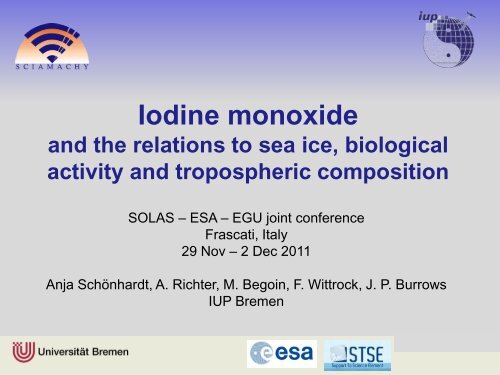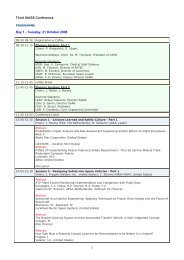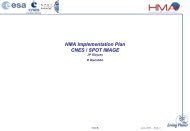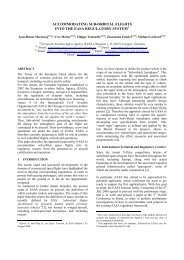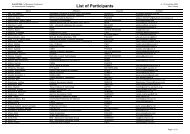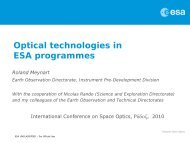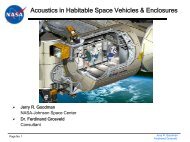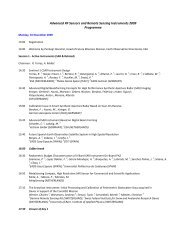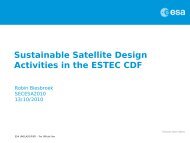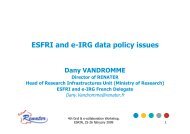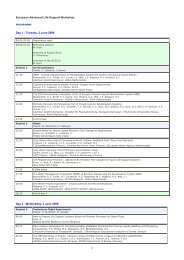Iodine Monoxide and the Relations to Sea Ice - Congrex
Iodine Monoxide and the Relations to Sea Ice - Congrex
Iodine Monoxide and the Relations to Sea Ice - Congrex
Create successful ePaper yourself
Turn your PDF publications into a flip-book with our unique Google optimized e-Paper software.
<strong>Iodine</strong> monoxide<br />
<strong>and</strong> <strong>the</strong> relations <strong>to</strong> sea ice, biological<br />
activity <strong>and</strong> tropospheric composition<br />
SOLAS – ESA – EGU joint conference<br />
Frascati, Italy<br />
29 Nov – 2 Dec 2011<br />
Anja Schönhardt, A. Richter, M. Begoin, F. Wittrock, J. P. Burrows<br />
IUP Bremen
The importance of iodine compounds<br />
<strong>Iodine</strong> radicals in <strong>the</strong> atmosphere<br />
� Change of tropospheric composition / oxodizing capacity<br />
- destruction of ozone<br />
- partitioning of HO x <strong>and</strong> NO x<br />
� Formation of fine new particles � growth <strong>to</strong> CCN<br />
<strong>Iodine</strong><br />
Precursors<br />
(mainly<br />
biogenic?)<br />
I 2<br />
CH 3I<br />
CH 2I 2<br />
CH 2ICl<br />
hn<br />
O 2<br />
I . O3 IO<br />
different branches<br />
IO observed in coastal areas, marine boundary layer, Polar sites<br />
Anja.Schoenhardt@iup.physik.uni-bremen.de<br />
SOLAS-ESA-EGU conference<br />
Frascati, 29 Nov – 2 Dec 2011<br />
2<br />
I xO y<br />
Halogens<br />
Fluorine<br />
Chlorine<br />
Bromine<br />
<strong>Iodine</strong><br />
Astatine<br />
McFiggans et al,<br />
ACP, 2004.<br />
with typical amounts 0-10 pptv (>20 pptv only sporadically)
Halogens in <strong>the</strong> Polar Regions<br />
Ozone depletion in <strong>the</strong> Arctic<br />
(Barrie et al, 1988)<br />
• anti-correlation of Bromine <strong>and</strong> Ozone<br />
• similar evolution of BrO <strong>and</strong> IO at Halley Station<br />
• strong temporal variability<br />
Br<br />
O 3<br />
� ozone depletion, mercury oxidation, particle formation<br />
� importance of halogens for Polar atmospheres<br />
IO/BrO observed in Antarctica<br />
(Saiz-Lopez et al, 2007)<br />
Anja.Schoenhardt@iup.physik.uni-bremen.de<br />
SOLAS-ESA-EGU conference<br />
Frascati, 29 Nov – 2 Dec 2011<br />
3
<strong>Iodine</strong> monoxide in <strong>the</strong> MBL<br />
IO maxima during low tide & day time<br />
Fine particle bursts coninciding with IO maxima<br />
G. McFiggans, 2010.<br />
K. L. Furneaux, 2010.<br />
Anja.Schoenhardt@iup.physik.uni-bremen.de<br />
SOLAS-ESA-EGU conference<br />
Frascati, 29 Nov – 2 Dec 2011<br />
4
Important questions <strong>and</strong> aspects<br />
Impact of gaseous iodine<br />
• Ozone destruction – what is <strong>the</strong> relevance?<br />
• Particle formation – what is <strong>the</strong> relative contribution?<br />
(cp. sulfate aerosol, sea salt aerosol, SOA etc)<br />
Main release pathways / connections of iodine <strong>to</strong> <strong>the</strong> biosphere<br />
From phy<strong>to</strong>plank<strong>to</strong>n / different groups / inorganic sources<br />
Required information<br />
• Column amounts / volume mixing ratios of iodine compounds<br />
(IO, I 2, OIO, precursors) …globally <strong>and</strong> long term<br />
• Altitude profiles of iodine compounds<br />
Anja.Schoenhardt@iup.physik.uni-bremen.de<br />
SOLAS-ESA-EGU conference<br />
Frascati, 29 Nov – 2 Dec 2011<br />
5
Overview<br />
Introduction:<br />
The SCIAMACHY instrument <strong>and</strong> <strong>the</strong> IO retrieval by DOAS<br />
Observations:<br />
• IO above Antarctica<br />
+ comparisons <strong>to</strong> sea ice cover<br />
• IO above oceanic regions<br />
+ comparisons <strong>to</strong> Chlorophyll-a content<br />
Anja.Schoenhardt@iup.physik.uni-bremen.de<br />
SOLAS-ESA-EGU conference<br />
Frascati, 29 Nov – 2 Dec 2011<br />
6
The satellite instrument<br />
SCIAMACHY: SCanning Imaging Absorption spectroMeter<br />
for Atmospheric CHar<strong>to</strong>graphY<br />
• UV-Vis-NIR spectrometer (214 – 2400 nm)<br />
• sun-synchronous orbit, 10:00 am equa<strong>to</strong>r crossing<br />
Geometry:<br />
960 km<br />
800 km<br />
30x60 km²<br />
ENVISAT:<br />
Fo<strong>to</strong>: ESA<br />
Anja.Schoenhardt@iup.physik.uni-bremen.de<br />
SOLAS-ESA-EGU conference<br />
Frascati, 29 Nov – 2 Dec 2011<br />
7
IO retrieval by Differential Optical Absorption Spectroscopy<br />
I 0<br />
I<br />
� I0<br />
( �)<br />
�<br />
k<br />
ln�� � �i<br />
( s)<br />
� i '(<br />
�,<br />
s)<br />
ds � ak�<br />
� r(<br />
�)<br />
I(<br />
�)<br />
�� �� �<br />
� � S i<br />
k<br />
Retrieval settings<br />
• Spectral range: 416 – 430 nm<br />
Anja.Schoenhardt@iup.physik.uni-bremen.de<br />
absorption term:<br />
• trace gases<br />
• Ring effect<br />
• Trace gases: IO, NO 2 (223K), O 3 (223K)<br />
• Ring effect, quadratic polynomial<br />
• Earthshine reference spectrum I 0<br />
polynomial:<br />
broad-b<strong>and</strong><br />
effects<br />
Result: Slant Column � i<br />
residual<br />
SC � � ( s)<br />
ds<br />
SOLAS-ESA-EGU conference<br />
Frascati, 29 Nov – 2 Dec 2011<br />
S<br />
i<br />
fitting<br />
window<br />
8
Results: IO from SCIAMACHY<br />
Anja.Schoenhardt@iup.physik.uni-bremen.de<br />
SOLAS-ESA-EGU conference<br />
Frascati, 29 Nov – 2 Dec 2011<br />
9
Global observations of IO slant columns<br />
IO present only in small amounts<br />
� Temporal averaging necessary<br />
Anja.Schoenhardt@iup.physik.uni-bremen.de<br />
SOLAS-ESA-EGU conference<br />
Frascati, 29 Nov – 2 Dec 2011<br />
10
Global observations of IO slant columns<br />
• IO above Antarctica<br />
• IO in East Pacific upwelling region<br />
Anja.Schoenhardt@iup.physik.uni-bremen.de<br />
SOLAS-ESA-EGU conference<br />
Frascati, 29 Nov – 2 Dec 2011<br />
11
180°<br />
IO over Antarctica – multi year composites<br />
Ross<br />
<strong>Ice</strong> Shelf<br />
Ross <strong>Sea</strong><br />
(Max. sea ice extent)<br />
90°W<br />
Antarctic Circle<br />
Filchner-Ronne<br />
Halley <strong>Ice</strong> Shelf<br />
Neumayer 0°<br />
Amery<br />
<strong>Ice</strong> Shelf<br />
90°E<br />
Weddell <strong>Sea</strong><br />
AMF for:<br />
90% reflecting ground<br />
1 km box profile<br />
Anja.Schoenhardt@iup.physik.uni-bremen.de<br />
SOLAS-ESA-EGU conference<br />
Frascati, 29 Nov – 2 Dec 2011<br />
12
IO above Antarctica<br />
Sep/Oct<br />
Dec/Jan<br />
Oct Oct/Nov Nov Nov/Dec Dec<br />
Jan Jan/Feb Feb Feb/Mar Mar<br />
6 year composites<br />
Anja.Schoenhardt@iup.physik.uni-bremen.de<br />
SOLAS-ESA-EGU conference<br />
Frascati, 29 Nov – 2 Dec 2011<br />
13
BrO above Antarctica<br />
Oct Nov Dec Jan Feb Mar<br />
• Appearance of IO <strong>and</strong> BrO both in Antarctic spring<br />
• Different spatial-temporal evolutions<br />
• IO above sea ice in spring time later than BrO<br />
=> different release pathways<br />
BrO data: Mathias Begoin <strong>and</strong> Andreas Richter<br />
6 year composites<br />
Anja.Schoenhardt@iup.physik.uni-bremen.de<br />
SOLAS-ESA-EGU conference<br />
Frascati, 29 Nov – 2 Dec 2011<br />
14
IO in Antarctica: relation <strong>to</strong> sea ice concentrations<br />
<strong>Sea</strong> ice influence<br />
• <strong>Sea</strong> ice reduces in late<br />
spring time<br />
• Phy<strong>to</strong>plank<strong>to</strong>n habitat<br />
beneath/within <strong>the</strong> sea ice<br />
• Contact <strong>to</strong> atmosphere<br />
facilitated when ice cover<br />
breaks open / melts<br />
<strong>Ice</strong> data:<br />
AMSR-E sensor<br />
L. Kaleschke, G. Spreen,<br />
Klima Campus, Hamburg.<br />
Oct Nov<br />
Anja.Schoenhardt@iup.physik.uni-bremen.de<br />
SOLAS-ESA-EGU conference<br />
Frascati, 29 Nov – 2 Dec 2011<br />
15
IO in Antarctica: relation <strong>to</strong> sea ice concentrations<br />
Science 282, 2238 (1998), K. M. Golden, et al. :<br />
The Percolation Phase Transition in <strong>Sea</strong> <strong>Ice</strong><br />
“For temperatures warmer than Tc [about -5°C],<br />
brine carrying heat <strong>and</strong> nutrients can move<br />
through <strong>the</strong> ice, whereas for colder temperatures<br />
<strong>the</strong> ice is impermeable.”<br />
• Biogenic release of iodine species is probable<br />
• <strong>Sea</strong> ice more porous in later spring time: contact<br />
between species below sea ice <strong>and</strong> air above<br />
• Strong biological productivity in cold Antarctic waters<br />
Anja.Schoenhardt@iup.physik.uni-bremen.de<br />
SOLAS-ESA-EGU conference<br />
Frascati, 29 Nov – 2 Dec 2011<br />
16
Connection of iodine <strong>to</strong> <strong>the</strong> biosphere (chlorophyll-a)<br />
• Long-term observations of<br />
IO <strong>and</strong> Chlorophyll-a<br />
• IO from SCIAMACHY<br />
• Chl-a from <strong>Sea</strong>WiFS<br />
• Care needed for IO absolute<br />
amounts over ocean regions<br />
• Enhanced IO at some<br />
biologically active regions<br />
• No clear correlation<br />
<strong>Sea</strong>WiFS data from NASA:<br />
http://oceancolor.gsfc.nasa.gov/cgi/l3<br />
Anja.Schoenhardt@iup.physik.uni-bremen.de<br />
SOLAS-ESA-EGU conference<br />
Frascati, 29 Nov – 2 Dec 2011<br />
17
Comparison: IO columns <strong>and</strong> chlorophyll-a content<br />
Observations:<br />
• Enhanced IO columns above <strong>the</strong><br />
Eastern Pacific<br />
• Spatial coincidence with enhanced<br />
Chlorophyll-a<br />
• No strong spatial correlation<br />
apparent at some o<strong>the</strong>r locations<br />
Thoughts:<br />
• Surfacing of <strong>the</strong> cold Humboldt<br />
current from <strong>the</strong> Antarctic<br />
• Connection of <strong>the</strong> specific<br />
biospheres?<br />
Anja.Schoenhardt@iup.physik.uni-bremen.de<br />
SOLAS-ESA-EGU conference<br />
Frascati, 29 Nov – 2 Dec 2011<br />
18
Comparison: IO columns <strong>and</strong> chlorophyll-a content<br />
Observations:<br />
• Slightly enhanced IO at some coasts<br />
• IO amounts partly correlated with<br />
Chl-a concentrations<br />
• No clear relationship:<br />
some regions with no relation<br />
between Chl-a <strong>and</strong> IO<br />
• no IO above <strong>the</strong> inl<strong>and</strong> lakes<br />
Implications:<br />
� no spectral interference<br />
� possibly better relation of IO with<br />
specific phy<strong>to</strong>plank<strong>to</strong>n groups<br />
(dia<strong>to</strong>ms?)<br />
Anja.Schoenhardt@iup.physik.uni-bremen.de<br />
SOLAS-ESA-EGU conference<br />
Frascati, 29 Nov – 2 Dec 2011<br />
19
Summary<br />
IO retrieval from SCIAMACHY<br />
• Multi year data set of IO columns (up <strong>to</strong> 2003 - 2010)<br />
• Conversion of IO slant columns <strong>to</strong> vertical columns<br />
IO above <strong>Sea</strong> <strong>Ice</strong> / Polar Regions<br />
• Strong detailed spatial <strong>and</strong> temporal variation<br />
• Striking differences in comparison <strong>to</strong> BrO<br />
• Enhanced IO above sea ice in late spring time<br />
• Link between IO enhancement <strong>and</strong> reduced ice concentration (still within <strong>the</strong> sea<br />
ice area, relation <strong>to</strong> phy<strong>to</strong>plank<strong>to</strong>n habitat, importance of ice temperature?)<br />
IO <strong>and</strong> Chlorophyll-a / Oceanic Regions<br />
• Some regions with correlation between IO <strong>and</strong> Chl-a, o<strong>the</strong>r regions with no relation<br />
• Importance of specific types of phy<strong>to</strong>plank<strong>to</strong>n is possible<br />
Anja.Schoenhardt@iup.physik.uni-bremen.de<br />
SOLAS-ESA-EGU conference<br />
Frascati, 29 Nov – 2 Dec 2011<br />
20
Outlook<br />
Next steps<br />
• Detailed correlation studies with <strong>the</strong> data presented<br />
(esp. IO – ice concentration)<br />
• Correlation studies with biospheric parameters<br />
(e.g. biogenic VOCs, Chl-a, dia<strong>to</strong>ms)<br />
� Determine conditions related <strong>to</strong> <strong>the</strong> presence of IO<br />
� Improve <strong>the</strong> underst<strong>and</strong>ing of <strong>the</strong> importance of atmospheric iodine<br />
• Potential for IO retrieval from fur<strong>the</strong>r instruments (GOME, GOME-2)<br />
Related posters:<br />
no.01 Itziar Alonso-Cañas (#57 Cook)<br />
no.05 Astrid Bracher (#28 Magellan)<br />
no.60 Rainer Volkamer (#22 Magellan)<br />
Anja.Schoenhardt@iup.physik.uni-bremen.de<br />
SOLAS-ESA-EGU conference<br />
Frascati, 29 Nov – 2 Dec 2011<br />
21
Acknowledgements<br />
• ESA, Changing Earth Science Network SciNet – funding of TIBAGS<br />
• Diego Fernández & Rober<strong>to</strong> Sabia<br />
• University Bremen<br />
• <strong>Sea</strong>WiFS data (NASA, National Aeronautics <strong>and</strong> Space Administration, USA)<br />
(available at <strong>the</strong> Ocean-Color webpage http://oceancolor.gsfc.nasa.gov)<br />
• AMSR-E sea ice data (L. Kaleschke & G. Spreen)<br />
(available at <strong>the</strong> Integrated Climate Data Center, Klima Campus, Uni Hamburg)<br />
Thank you for listening!<br />
Anja.Schoenhardt@iup.physik.uni-bremen.de<br />
SOLAS-ESA-EGU conference<br />
Frascati, 29 Nov – 2 Dec 2011<br />
22
The End<br />
Anja.Schoenhardt@iup.physik.uni-bremen.de<br />
SOLAS-ESA-EGU conference<br />
Frascati, 29 Nov – 2 Dec 2011<br />
23
The End<br />
Anja.Schoenhardt@iup.physik.uni-bremen.de<br />
SOLAS-ESA-EGU conference<br />
Frascati, 29 Nov – 2 Dec 2011<br />
24
transfer<br />
<strong>to</strong> l<strong>and</strong>/ice<br />
precipitation<br />
deposition<br />
?<br />
Why should we care about iodine compounds?<br />
aerosol particles<br />
inorganic<br />
Recycling/<br />
Re-emission<br />
?<br />
ice algae<br />
McFiggans et al,<br />
ACP, 2004.<br />
phy<strong>to</strong>plank<strong>to</strong>n/algae<br />
?<br />
iodine oxides<br />
I xO y<br />
different<br />
pathways<br />
I 2<br />
CH 3I CH 2I 2<br />
Anja.Schoenhardt@iup.physik.uni-bremen.de<br />
SOLAS-ESA-EGU conference<br />
Frascati, 29 Nov – 2 Dec 2011<br />
25<br />
?<br />
IO<br />
I<br />
O 2 ozone depletion<br />
O 3<br />
hn<br />
CH2ICl CH3I HX, XO<br />
soils<br />
rice paddies<br />
salt lakes<br />
vulcanoes<br />
biomass<br />
burning<br />
Small drawings from:<br />
www.vskrems.lerchenfeld.ac.at
<strong>Iodine</strong> monoxide in <strong>the</strong> MBL<br />
(L. Carpenter et al, 2001)<br />
• anti-correlation of IO <strong>and</strong> tidal height<br />
• presence of macro algae (oxidation<br />
processes during low tide)<br />
• correlation of IO with solar irradiance<br />
(pho<strong>to</strong>chemistry)<br />
� importance of halogens for <strong>the</strong><br />
marine boundary layer<br />
Anja.Schoenhardt@iup.physik.uni-bremen.de<br />
SOLAS-ESA-EGU conference<br />
Frascati, 29 Nov – 2 Dec 2011<br />
26
180°<br />
(Max. sea ice extent)<br />
3. <strong>Iodine</strong> monoxide above Antarctica<br />
90°W<br />
Antarctic Circle<br />
Halley<br />
Neumayer<br />
90°E<br />
Anja.Schoenhardt@iup.physik.uni-bremen.de<br />
SOLAS-ESA-EGU conference<br />
Frascati, 29 Nov – 2 Dec 2011<br />
27<br />
0°<br />
• ~10 14 molec/cm²dSCD of IO<br />
• several ppb IO in snow pack?<br />
(Friess et al 2001, 2009)<br />
(Saiz-Lopez et al, 2007)<br />
organic iodocarbons in sea water<br />
CH 2I 2, CH 2IBr, CH 2ICl<br />
(Carpenter et al, 2007)
90°W<br />
Hudson<br />
Bay<br />
(Max. sea ice extent)<br />
3. <strong>Iodine</strong> monoxide above Antarctica<br />
Alert<br />
180°<br />
Arctic<br />
Ocean<br />
Ny-Ålesund<br />
0°<br />
Bremen<br />
Anja.Schoenhardt@iup.physik.uni-bremen.de<br />
Arctic Circle<br />
90°E<br />
(Barrie et al, 1988)<br />
Br<br />
O 3<br />
• BrO up <strong>to</strong> 20 ppt<br />
• IO below <strong>the</strong> detection limit<br />
(Hönninger et al, 2004)<br />
• IO ~3 ppt on two occasions<br />
(Oetjen, 2009, Mahajan pers. comm.)<br />
Update!<br />
• IO dSCD ~10 13 molec/cm²< 1ppt<br />
(Wittrock et al, 2000; Oetjen 2009)<br />
SOLAS-ESA-EGU conference<br />
Frascati, 29 Nov – 2 Dec 2011<br />
28
Vertical columns of iodine monoxide<br />
Retrieval method: Differential Optical Absorption Spectroscopy<br />
Result from DOAS retrieval: slant column amounts SC<br />
Meaningful quantity<br />
for investigations: vertical columns VC<br />
Geometry Air Mass Fac<strong>to</strong>r AMF<br />
• calculated via radiative transfer model SCIATRAN<br />
• correction fac<strong>to</strong>r <strong>to</strong> account for <strong>the</strong> relative path<br />
length through <strong>the</strong> absorber layer<br />
SC(<br />
�,<br />
SZA,<br />
�,...)<br />
AMF ( �, SZA,<br />
�,...)<br />
�<br />
VC<br />
SC(<br />
�,<br />
SZA,<br />
�,...)<br />
VC �<br />
AMF ( �,<br />
SZA,<br />
�,...)<br />
Anja.Schoenhardt@iup.physik.uni-bremen.de<br />
SOLAS-ESA-EGU conference<br />
Frascati, 29 Nov – 2 Dec 2011<br />
29<br />
�<br />
SC � � ( l)<br />
dl<br />
VC<br />
i<br />
i<br />
L<br />
�<br />
z�0<br />
L �L(<br />
�, SZA,<br />
�,...)<br />
i<br />
TOA<br />
� � ( z)<br />
dz<br />
i
Vertical columns of IO – AMF studies<br />
Influencing parameters (examples):<br />
• Ground reflectance<br />
• Solar Zenith Angle<br />
• Absorber altitude profile<br />
• Aerosol scenario<br />
Results from sensitivity studies<br />
� Sensitivity for IO detection much better above<br />
bright surfaces<br />
� Dependency on altitude profile small for bright<br />
surfaces, larger for dark surfaces<br />
� Influence from aerosol amount smaller above<br />
bright surfaces<br />
� More detailed AMF studies including aerosoles<br />
<strong>and</strong> measured IO altitude profiles necessary<br />
90 % reflecting surface<br />
5 % reflecting surface<br />
Anja.Schoenhardt@iup.physik.uni-bremen.de<br />
SOLAS-ESA-EGU conference<br />
Frascati, 29 Nov – 2 Dec 2011<br />
30
Vertical columns of IO – AMF studies<br />
Sensitivity <strong>to</strong> ground layers:<br />
• Reduced sensitivity for darker sufaces<br />
• Enhanced visibility of IO above bright<br />
surfaces<br />
• For precise quantitative studies, <strong>the</strong><br />
ground reflectance needs <strong>to</strong> be taken<br />
in<strong>to</strong> account<br />
Anja.Schoenhardt@iup.physik.uni-bremen.de<br />
SOLAS-ESA-EGU conference<br />
Frascati, 29 Nov – 2 Dec 2011<br />
31
Improving <strong>the</strong> basic satellite data set<br />
NRT data set Consolidated data set<br />
Consolidated data set<br />
• Consistent amounts with inital product<br />
• Improved quality (less noise) due <strong>to</strong> improved background consideration<br />
• Extended, consistent time series now processed <strong>and</strong> ready <strong>to</strong> use (2003-2010 ongoing)<br />
Anja.Schoenhardt@iup.physik.uni-bremen.de<br />
SOLAS-ESA-EGU conference<br />
Frascati, 29 Nov – 2 Dec 2011<br />
32
The very End<br />
(Lizotte, 2001)<br />
Primary productivity in <strong>the</strong> Antarctic sea ice surface communities by<br />
month as modeled by Arrigo et al. (1998b). Symbols: multi-year ice<br />
(triangles); first-year ice (squares); <strong>and</strong> <strong>to</strong>tal sea ice (circles).<br />
Anja.Schoenhardt@iup.physik.uni-bremen.de<br />
SOLAS-ESA-EGU conference<br />
Frascati, 29 Nov – 2 Dec 2011<br />
33
The very End<br />
(Lizotte, 2001)<br />
Primary productivity in <strong>the</strong> Antarctic sea ice zone (SIZ) by month as<br />
modeled by Arrigo et al. (1998b,c). Symbols: SIZ <strong>to</strong>tal (triangles);<br />
MIZ water (diamonds); shelf water (squares); <strong>and</strong> sea ice (circles).<br />
Anja.Schoenhardt@iup.physik.uni-bremen.de<br />
SOLAS-ESA-EGU conference<br />
Frascati, 29 Nov – 2 Dec 2011<br />
34


